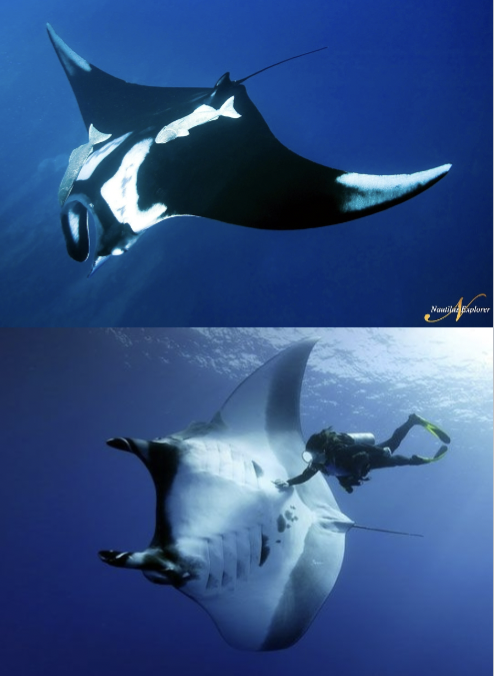Marine Vert Lecture 7 (Chondrichthyes)
1/69
Earn XP
Description and Tags
Lecture 7 slides content
Name | Mastery | Learn | Test | Matching | Spaced |
|---|
No study sessions yet.
70 Terms
Fishes make up _____ of living vertebrates:
Half
Two-thirds
One-fourth
Half
True or False: Fishes are the ecological dominants of aquatic habitats.
True. Many of them, like sharks, are apex predators.
What is Berra’s definition of fish (2001)
A poikilothermic, aquatic chordate with appendages (when present, developed as fins) whose chief respiratory organs are gills and whose body is usually covered with scales.
What is Nelson’s definition of fish (2006)
Aquatic vertebrate with gills and limbs in the shape of fins.
True or False: fish is a very specific term.
False. Fish is a general term because they are hard to define.
True or False: Fishes were the first vertebrates.
True, and there are more fish species than all other vertebrate species combined.
True or False: The vast majority of fishes are Osteichthyes.
True. Of the ~32,000 extant fish species, only 108 are jawless fishes and 970 are cartilaginous fishes, meaning the rest are bony fish.
What are examples of valuable databases for fish systematics?
WORMS
Encyclopedia of Life
Fishbase
Methods like molecular sequencing, 3D imaging, and developmental biology are tools for finding information concerning fish systematics.
What are a few reasons why fishes are important to people?
Diet staple
• Atlantic Cod fish to the brink of extinction
Important element of the economy
• Recreation & psychological value to naturalists, sports enthusiasts, and home aquarists
Subject of international and domestic agreements and disagreements
General indicators of pollution
Studied in behavior, ecology, evolution, genetics, physiology
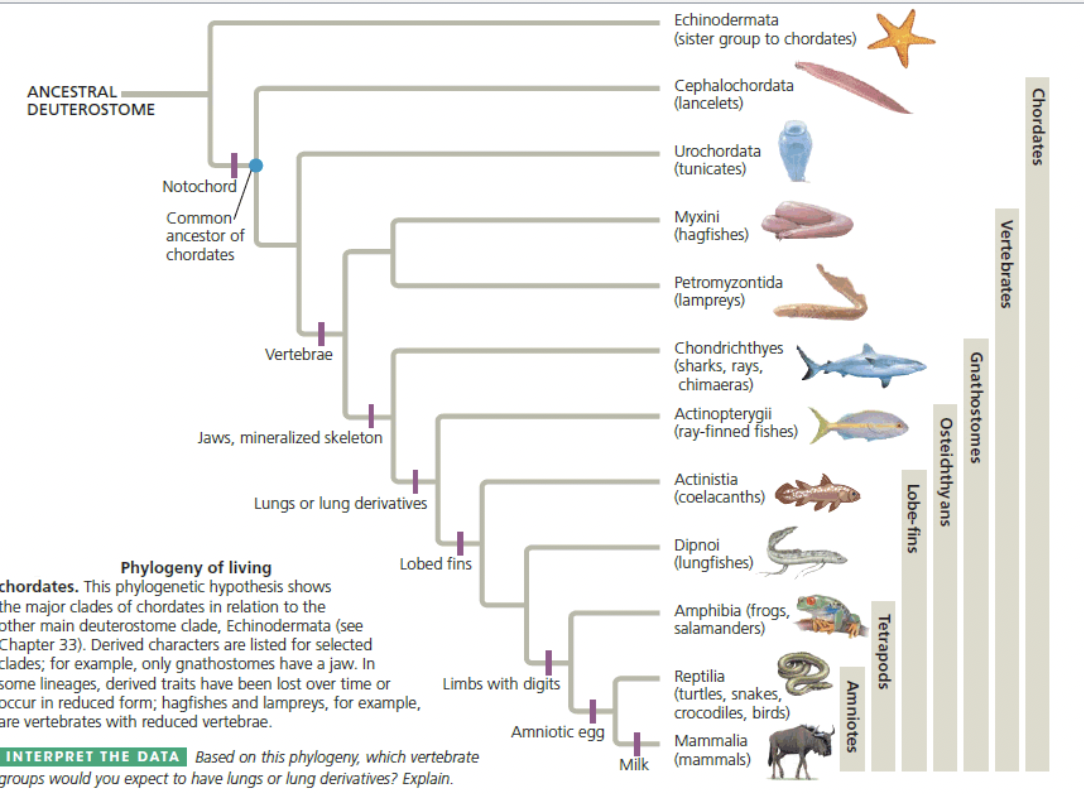
According to this phylogenetic tree, which group of fishes is the most ancestral?
Myxini (hagfishes)
Describe a brief history of fishes.
During 500 million years of evolution, fishes colonized and dominated the seas and fresh waters and eventually emerged, at least for short periods, onto land
• Extant (“living”) fishes represent the most recent manifestations of adaptations and lineages that have their roots in the early Paleozoic
• By the time fishlike fossils appear in Early Cambrian deposits, (~530 mya) complex tissue types had evolved, filamentous gills, V- shaped myomeres, and a distinct dorsal fin
Who were the first fishes?
Angnatha/Ostracodermi (jawless fishes with bony armor and endoskeleton)
Appear in Cambrian fossils
Later the Ostracaderms disappeared and Placoderms appeared in Devonian fossils with paired fins
What era did Chondrichthyes first appear in?
They appeared in the late Devonian period and are characterized by a terminal mouth, pectoral fins broadly joined to the body, and at first didn’t have pelvic claspers.
What are extant jawless fishes called?
Cyclostomes. They have paired fins, one nostril, pouched gills with branchial supports, a tongue with keratin “teeth” and vertebral precursors called arcualia.
Within the Infraphylum Agnatha and Superclass Cyclostomes, what are the two Classes we studied?
Myxiniformes and Petromyzontiformes.
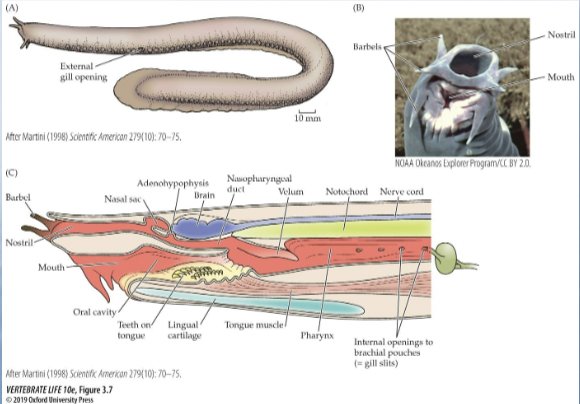
What are characteristics of Class Myxiniformes (hagfish)?
• 75 spp. in two genera: Eptatretus & Myxine
• Entirely marine
• World-wide distribution, except for polar regions
• Primarily deep-sea, cold-water
• Scavengers of the deep-sea floor
• Slime glands: open to body wall via 90-200 pores and secrete enormous amounts of
mucus and tightly coiled proteinaceous threads
Coiled threads straighten when contact with seawater and entrap mucus close to
the hagfish's body
Deters predators
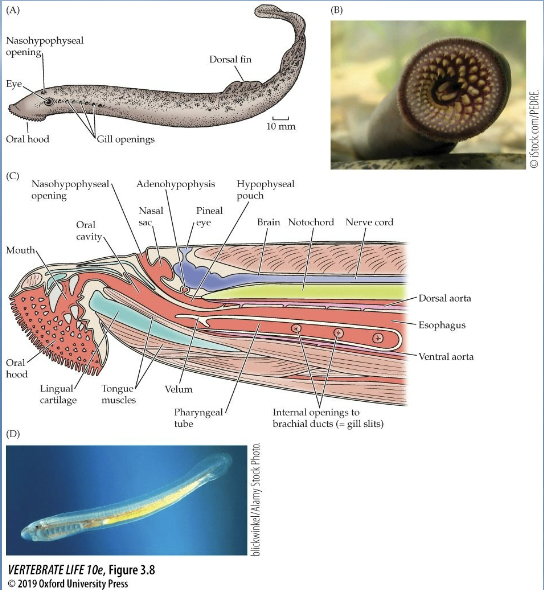
Characteristics of Class Petromyzontiformes (lampreys):
• 40 spp. of lampreys in 2 major genera: Petromyzon & Lampetra
• Andadromous
• 10cm to 1m
• 7 pairs of gill pouches
• Round mouth
• Large eyes, with well-developed vision
• Pineal body: light sensitive structure that is homologous with the pineal gland of mammals
• Adults use tidal ventilation: water is drawn in and expelled through the gill openings
Inefficient, but necessary due to mode of feeding
• Parasitic
What does it mean for an organism’s mouth if it is a gnathostome?
Gnathostomes are jawed fishes. Jaws allow for new feeding behaviors and food sources.
True or False: Gnathostomes have two sets of paired limbs.
True. These are the pectoral and pelvic, and they allow for sophisticated locomotion and control of the body in a 3D space.

According to this figure, which extant group evolved last (most recently)?
Sharks
What two groups are within Parvphylum Chondrichthyes?
• Elasmobranchii (plate gills)
Multiple gill openings on each side of head
Sharks, rays, skates
• Holocephali (whole head)
Named for undivided appearance of the head that results from a single gill opening
Gill slits are covered by opercular cartilage
Chimeras, rabbitfishes, ratfishes, ghost sharks
Fish-like body with long flexible tail
What are some examples of distinctive Chondrichthyes characteristics?
• Pelvic claspers in males which are used for internal fertilization
• Placoid scales: dermal denticles
• Tooth whorl: teeth are continually replaced as they wear down or fall off
• Cartilaginous skeleton: falls apart after death
• Chondrichthyans are largely known from fossil teeth
What order of fish did we learn about within the subclass Holocephali (rat fishes)?
Chimaeriformes – deep-water inhabiting, single gill opening, bulky head, venomous spine in front of dorsal fin
What superorders are within the clade Neoselachii (In subclass Elasmobranchii)? What are some of their distinguishing characteristics?
• Superorder Galeomorphi – anal fin present
• ragged toothed sharks, mackerel sharks, megamouth sharks, thresher sharks, requiem
sharks, hornsharks, wobbegongs, nurse sharks, and whale sharks
• Superorder Squalomorphi – lack anal fin
• deep-sea sharks, dogfish sharks, angel sharks, and saw sharks (not monophyletic,
data lacking)
• Superorder Batoidea – all skates and rays
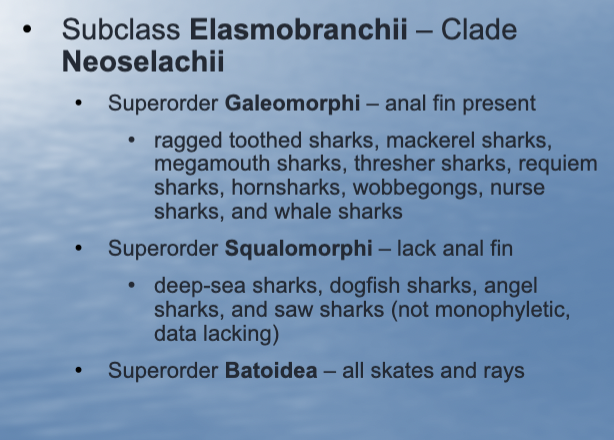
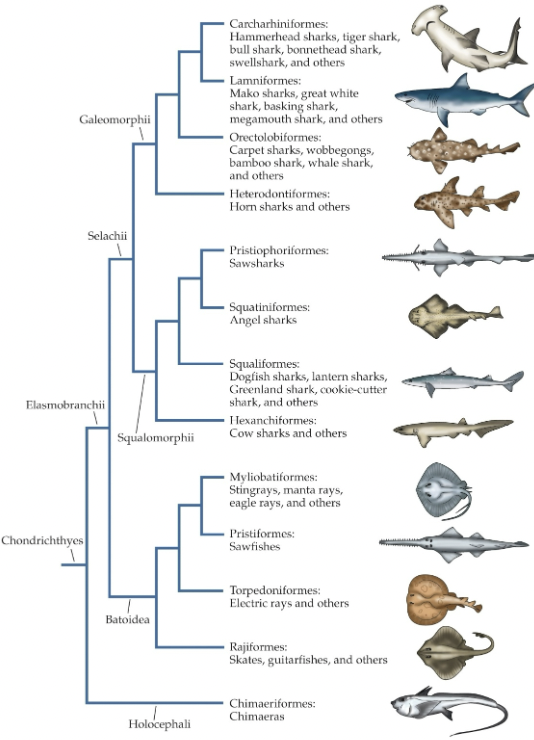
According to this phylogenetic tree, which group of fishes is the most basal/ancestral?
Holocephali—>Chimeraformes
Characteristics of Holocephali (Chimaeras):
• Single gill opening on each side
• No spiracle
• Teeth are modified into tooth plates
• Long body that ends in a whiplike tail
• Swim with lateral undulations of body
• Live at depths of 500 meters or more
• Males and females spend most of the year in separate areas and come together only during annual inshore spawning migration
• 10-12 years to reach maturity
Chimaeriformes class: (NOT in elasmobranchii)
Chimaeriformes – ratfishes – deep-water, upper jaws fused to skull, opercula
Rajiformes class:
guitarfish and skates – rajiform swimming (undulating pec. Fins), enlarged pectoral fins
Torpediniformes class:
Torpediniformes – electric rays – produce electric discharge
Pristiformes class:
sawfish – long snout with numerous teeth
Myliobatiformes class:
Myliobatiformes – sting rays, manta rays, eagle rays – swim by flapping pectoral fins
Hexanchiformes class:
Hexanchiformes – cow sharks, frilled sharks – 6 or 7 gill slits
Squaliformes class:
dogfish, lanternshark – two dorsal fins with spines, no anal fin, 5 gill slits
Squatiniformes class:
Squatiniformes – angel sharks – two dorsal fins, no anal fin, pectoral and pelvic fins broad
Pristiophoriformes class:
Pristiophoriformes – saw sharks – lengthened snout, two dorsal fins, no anal fin
Heterodontiformes class:
Heterodontiformes – horn sharks/ bullhead shark – mouth anterior to orbits, two dorsal fins with spines
Orectolobiformes class:
Orectolobiformes – whale, bamboo, nurse – two dorsal fins, small gill slits, 4th and 5th overlapping
Lamniformes class:
Lamniformes – great white, thresher, basking – two dorsal fins, 5 gill slits
Carcharhiniformes class:
Carcharhiniformes – hammerhead, bonnethead, blacktip reef, bull – two dorsal fins, anal fin, 5 gill slits, nictitating membrane
What is bioluminescence?
• Bioluminescence: skin of some species of sharks and rays emits light
• Some squaliform sharks have photophores: specialized luminous cells
• Light production is thought to be controlled by hormones
• May help camouflage fish by counterillumination, concealing the silhouette
What is biofluorescence?
• Biofluorescence: skin of some species absorbs light of one wavelength and re-emits it at a different wavelength
• In some rays & squaliform sharks
• Absorb blue light and emit green
• Probably used for communication
What is the infraclass for sharks?
Selachii
What is Rhincodon typus? What are characteristics of this organism?
It’s a whale shark!
Large, filter feeding, checkered color pattern, humpback, lunate tail
Largest fish in world
Range: Circumtropical
Diet: plankton
Threats: harvest, bycatch, vessel strikes
Viviparous: Age at Maturity: 17 (M), 19-22 (F)
Remigration Interval: 2- 7 years, Clutch Frequency: 3 - 7 years
IUCN status: Endangered
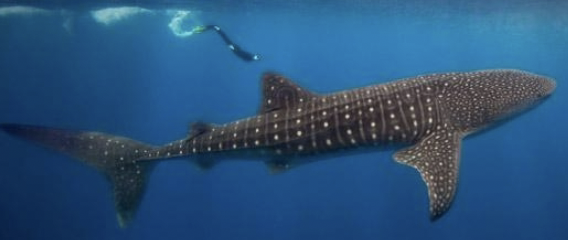
What are characteristics of requiem sharks (family Carcharhinidae)?
2 dorsal fins, upper lobe of caudal fin is elongate and pointed upward, teeth blade-like cusps,
usually only 1 row of teeth is functional at once
What is Carcharhinus leucas? What are characteristics of this organism?
It’s a bull shark!
Inshore
No spiracle
Move between freshwater and saltwater
Aggressive
IUCN status: vulnerable
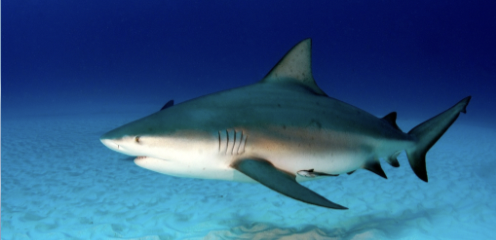
What is Carcharhinus limbatus? What are characteristics of this organism?
It’s a blacktip shark!
coastal and offshore
tips of dorsal, caudal, anal, and pelvic fins are black (pelvic distinguishes from spinner sharks)
IUCN status: vulnerable
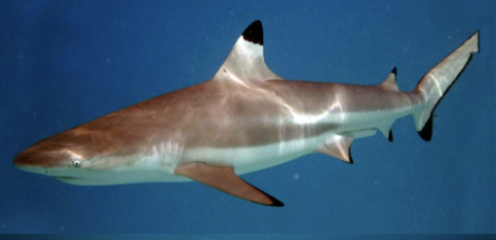
What is Galeocerdo cuvier? What are characteristics of this organism?
It’s a tiger shark!
Coastal and offshore
Dark spots form dorso-ventral bars along the body
Small spiracle
Caudal peduncle has a dermal ridge on each side
IUCN status: near threatened

What are characteristics of hammerhead sharks (family sphyrnidae)?
Greatly depressed and laterally expanded head, greatly expands vision field, may increase electrosensitivity.
What is Sphyrna lewini? What are characteristics of this organism?
It’s a scalloped hammerhead!
Anterior margin of head with median indentation, eye large, separate from nostril by distance equal to diameter of eye
Near ocean surface, sometimes in estuaries, can form aggregations
Viviparous
Diet: fish, squid, stingrays
Threats: harvest, bycatch
IUCN status: Critically endangered
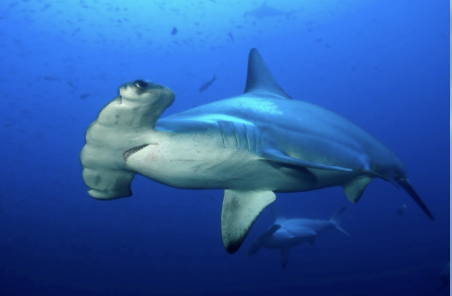
What is Sphyrna tiburo? What are characteristics of this organism?
It’s a bonnethead shark!
Anterior (head) margin rounded or bonnetlike, without indentations
Shallow inshore water
Diet: Crustaceans, mollusks, fishes
IUCN status: endangered
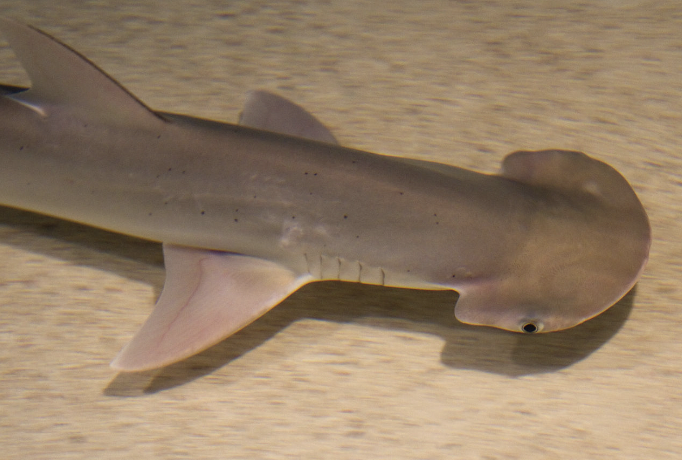
What are the three basic mechanisms of prey capture for sharks?
• Biting: opening mouth and closing it on large prey, usually tearing out a chunk of flesh and leaving wounds
• Engulfing: engulf prey with open mouth
• Suction: to draw prey into mouth
What internal feature in sharks can be used to distinguish them from each other?
Teeth

What factors are causing a decline in populations of sharks?
• Life history makes vulnerable:
Low fecundity: ovoviviparity and viviparity, reproductive frequency, small litter size, and late maturity (150 yrs in Greenland shark)
• Young depend on nursery grounds
Reproductive migratory behavior exposes sharks to various fishing fleets and other human impacts
• Apex predators are overfished and now rare
Exert control on marine ecosystem and loss can cause booms in lower trophic level species (predator release, trophic cascades, etc.)
• Shark fisheries are rapidly developing and expanding globally, bycatch
• Shark finning – sharkfin soup, or purported medicinal properties, extremely valuable in some markets
Fins retained and body discarded
• Human fear and wanton killings (bycaught sharks often killed even if not desired for food resource).
What superorder are skates and rays in?
Batoidea
What are characteristics of batoidea (skates and rays)?
• Dorsoventrally compressed
• Mouth and gills on ventral surface
• Eyes and spiracle on dorsal surface
• When resting on the bottom, water is drawn through the spiracle and exhausted through the gill slits
• Enlarged pectoral fins attached to side of head
• Scales are absent from large areas of the body & pectoral fins
• Many are ambush predators
• Largest rays are plankton strainers
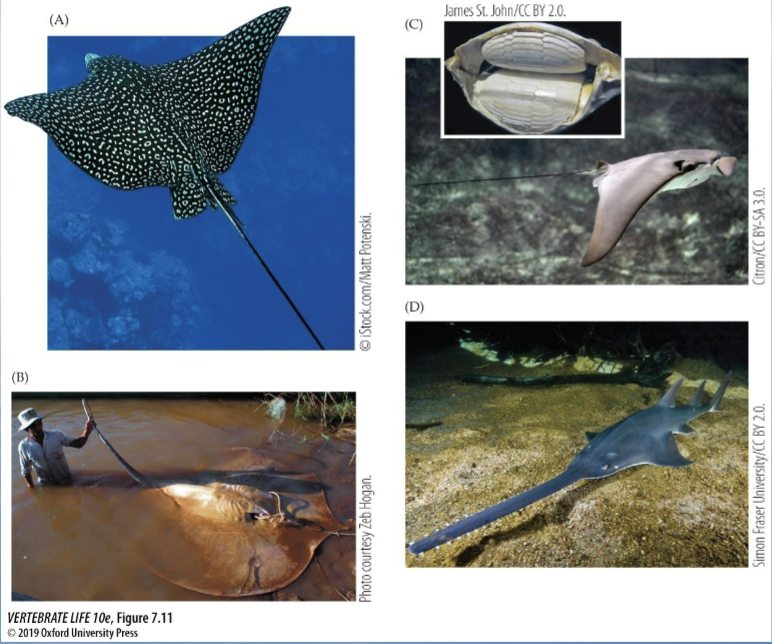
Is this trait indicative of a skate or ray?
Oviparous: deposit eggs in stiff cases
Skates make “Mermaid purses” that are their egg cases.
Is this trait indicative of a skate or ray?
Viviparous with varying degrees of matrotrophy.
Rays are viviparous.
True or False: Skates have whiplike tails with barbs, and rays have thick tails with no spines and two dorsal fins.
False. Skates have thick tails and rays have whiplike tails.
True or False: In general, skates have a circular body outline and rays are kite-shaped
True. This is clearly seen with eagle rays.
What is Pristis pectinata? What are characteristics of this organism?
It’s a smalltooth sawfish!
• Moderately depressed body, snout with 24 or more teeth on each side
• Habitat: Estuaries, lower parts of rivers, shallow coastal waters
• Reproduction: Lecithotrophic viviparous
• Diet: crustaceans, mollusks
• IUCN status: Critically endangered
• Threats: harvest, bycatch
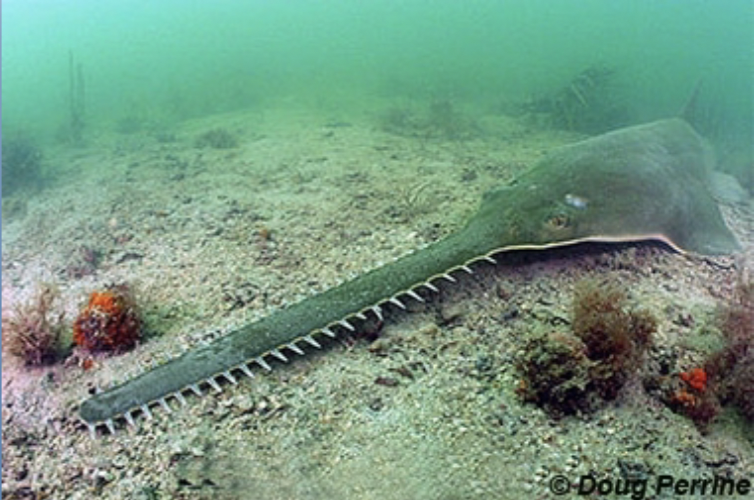
What are characteristics of the family pristidae? (Sawfishes)
• 2 well developed dorsal fins, saw-like rostrum, armed on both sides with teeth, coastal, can swim upstream to freshwater
• Rostrum used for prey detection in benthos, digging or grubbing in sand
What are characteristics of the family rajidae? (skates)
Body disc-like, wings shaped by pectoral fins and attached to head, dorsal, anal, and caudal fins reduced
What is Raja eglanteria? What are characteristics of this organism?
It’s a clearnose skate!
• Sides of snout translucent, no ocellar spots, entire tail thorny
• Diet: mollusks, crustaceans
• Habitat: shallow shores,
• Reproduction: oviparous
• IUCN Status: Least Concern
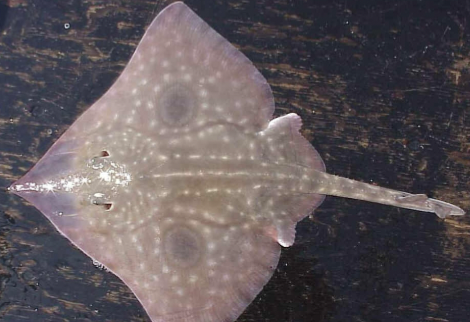
What are characteristics of the family Dasyatidae? (Stingrays)
Body greatly depressed, tail distinct from body, pectoral fins extend forward beyond mouth, dorsal fin absent
What is Hypanus americanus? What are characteristics of this organism?
It’s a Southern Stingray!
• Body roughly rhombic, outer corners of disc sharply rounded
• Habitat: near shores and bays
• Diet: mollusks, crustaceans, polychaetes, nocturnal foraging
• Reproduction: ovoviviparous
• IUCN Status: near threatened

What are characteristics of family Myliobatidae? (Eagle rays)
Robust body with falcate pectoral fins, disc wider than long, anterior parts of pectoral fins form 1 or 2 subrostral lobes under snout
What is Aetobatus narinari? What are characteristics of this organism?
It’s a spotted eagle ray!
Head distinct from body, tail very long and whiplike, spots can be white, yellow, or blue
Habitat: coastal surface waters
Behavior: solitary, forms schools only for spawning or migrating, when pursued make spectacular leaps into the air
Diet: mollusks, crustaceans
Reproduction: ovoviviparous
IUCN status: Endangered
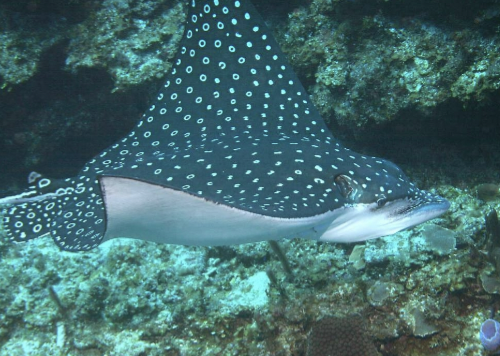
What is Rhinoptera bonasus? What are characteristics of this organism?
It’s a cownose ray!
• Cownose ray (Rhinoptera bonasus) – sharply angled wing tips, massive snout nearly split with a midline grove
• Habitat: near shores and bays
• Diet: mollusks, forms large feeding schools
• Reproduction: viviparous
• IUCN Status: vulnerable

What are characteristics of the family Mobulidae? (Mantas)
• Lack large tooth plates, anterior subdivisions of pectoral fins modified as 2 separate fins known as cephalic fins, posterior edges of pectoral fins are falcate, north American mantas lack a spine.
• Cephalic fins are used for steering and directly food into mouth
What is Mobula birostris? What are characteristics of this organism?
It’s the atlantic manta!
Disc twice as broad as long, cephalic fins large, widely set, forward directed and horn like, mouth terminal, teeth only in lower jaw
• Habitat: Offshore deep water, pelagic, may leap out of water or bask at surface
• Behavior: solitary, may forms schools, may visit cleaning stations
• Diet: filter feeder; plankton
• Reproduction: ovoviviparous, pup hatches internally and receives milky secretion from mother before birth, 1-2 brood size
• IUCN Status: Endangered
